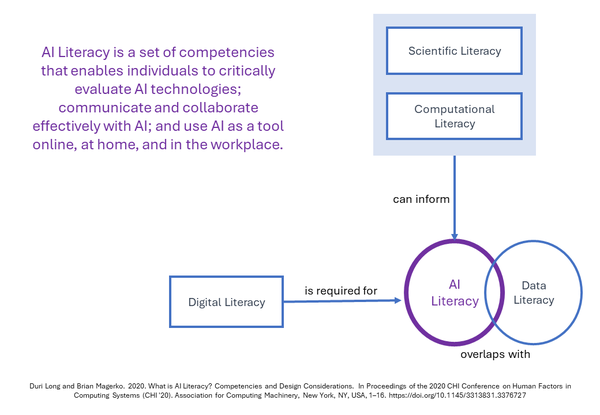AI and data literacy
AI literacy

AI literacy (alongside data/digital literacy)
Scale:
- Applicable to the entire workforce, from entry-level to executive roles
- Requires organisation-wide training and awareness initiatives
Impact:
- Enables effective communication and collaboration around AI initiatives
- Helps employees understand the implications of AI on their roles and the organisation
- Facilitates informed decision-making and responsible use of AI technologies
Using SFIA
- The SFIA framework does not include data, digital or AI literacy scales although some of the elements of these can be found in the generic attributes
- It's important to note that the scales used for literacy and fluency are different from SFIA's levels of responsibility, even if they sometimes appear similar (e.g., using a numeric scale).
- Literacy and fluency scales can be used alongside SFIA, but the distinction between the two should be made clear.
SFIA skills
- SFIA provides several skills for learning and development professionals involved in building AI and data literacy:
| SFIA skill - name | Code | SFIA skill - concise description | Illustrative applications |
| AI and data ethics | AIDE | Implementing and promoting ethical practices in the design, development, deployment, and use of AI and data technologies. |
Ensuring AI systems used for patient diagnosis comply with ethical standards to protect patient privacy and ensure unbiased outcomes. Developing an AI ethics training program for employees involved in AI projects to ensure responsible AI development and deployment. |
| Learning design and development | TMCR | Designing and developing resources to transfer knowledge, develop skills and change behaviours. | Creating an interactive e-learning course on AI fundamentals for employees across different departments to build a foundation of AI literacy. |
| Content authoring | INCA | Planning, designing and creating textual information, supported where necessary by graphical content. |
Writing a series of articles or blog posts explaining key AI concepts and their applications in various business contexts to raise awareness and understanding. |
| Learning delivery | ETDL | Transferring knowledge, developing skills and changing behaviours using a range of techniques, resources and media. |
Workshops: Conducting interactive workshops where employees learn about AI through hands-on activities and collaborative projects. Webinars: Hosting online seminars to teach remote employees about AI developments and their implications for the business. |
| Competency assessment | LEDA | Assessing knowledge, skills, competency and behaviours by any means, whether formal or informal, against frameworks such as SFIA. | Designing assessments to measure employees' understanding of AI concepts and their ability to apply AI tools in their daily tasks. |
Overlap between AI literacy and data literacy
Understanding of data
- Common ground: Both AI literacy and data literacy require individuals to understand how data is collected, processed, and analysed.
- Data literacy focus: Reading, understanding, and communicating data within decision-making processes.
- AI literacy focus: Extends data literacy capabilities to include comprehension of how data informs AI models, influencing automated decisions and predictive analytics.
Critical evaluation
- Data evaluation: Essential for critically evaluating sources of data and the outputs from data analysis.
- AI evaluation: Involves evaluating the outputs of AI models, understanding their limitations, biases, and the ethical considerations of their application.
Utilisation of tools
- Data literacy tools: Involves using tools and software for basic data analysis.
- AI literacy tools: Encompasses the use of AI platforms and tools that automate or provide more advanced analyses.
Decision-making and problem-solving
- Enhanced decision-making: Both literacies contribute to more informed and effective decision-making processes.
- AI augmentation: AI literacy allows for leveraging AI technologies to automate and augment decision-making, especially in complex scenarios involving predictive analytics.
Integration and synergy
- Integrated training: Promotes an integrated approach to employee training and workflow design, empowering employees to leverage data effectively.
- Workforce proficiency: Supports the creation of a workforce proficient in navigating the complexities of modern data landscapes and AI technologies, enhancing organisational productivity and innovation.
Digital literacy as a foundation for AI literacy
Summary: Digital literacy is not just a complementary skill but a prerequisite for AI literacy. It equips individuals with the fundamental understanding and skills needed to operate in a digital environment, essential for effectively using AI technologies.
Basic technology skills
- Essential skills: Digital literacy provides the skills needed to use computers, smartphones, and other digital devices necessary for engaging with more advanced technologies like AI.
- Navigational skills: Includes navigating operating systems, using common software applications, and understanding the internet and cloud services, integral to operating AI-powered tools.
Understanding of digital content
- Content management: Digital literacy involves understanding how digital content is created, managed, and manipulated, crucial for comprehending how data is used and manipulated by AI systems.
- AI interaction: Being literate in digital content allows individuals to discern how AI models are trained with data and how these models generate outputs, making it easier to interact with AI applications effectively.
Critical thinking and online communication
- Evaluation and communication: Digital literacy enhances critical thinking and effective online communication, essential competencies for engaging with AI.
- Collaborative environments: Users must critically evaluate data-driven outputs, understand their sources, and communicate findings or discrepancies effectively, especially in collaborative environments that use AI.
Safety and security online
- Digital security: Understanding digital security is vital for AI literacy, particularly because AI systems frequently process sensitive data.
- Privacy and cybersecurity: Knowledge of data privacy, cybersecurity practices, and data integrity helps users navigate the security implications of AI technologies, ensuring secure interactions and compliance with legal and ethical standards.
Seamless transition to AI tools
- Adaptability: Digital literacy facilitates a smoother transition to using AI tools by providing users with the skills to adapt quickly to new technologies.
- Effective usage: Digitally literate individuals are more likely to effectively use and troubleshoot AI applications, integrate them into daily tasks, and maximize their potential benefits in various contexts.